实验6:开源控制器实践——RYU
一、基本要求
1.通过Ryu的图形界面查看网络拓扑
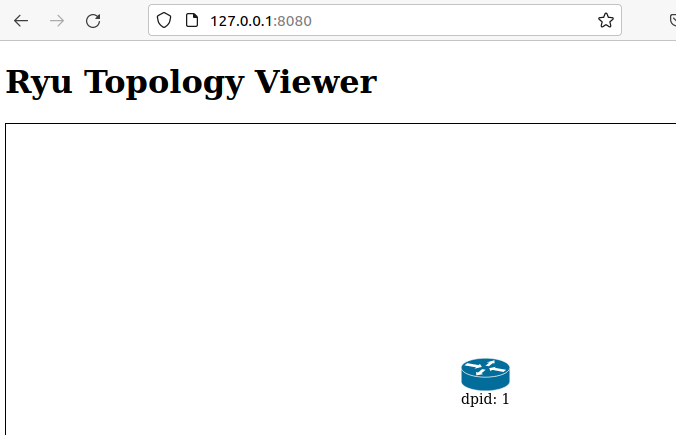
2.运行当中的L2Switch,h1 ping h2或h3,在目标主机使用 tcpdump 验证L2Switch,分析L2Switch和POX的Hub模块有何不同。
- 运行
![]()
- h1 ping h2 (h2和h3都可以看到)
![]()
- 查看流表
![]()
所以,不同之处在于L2Switch不可以查看下发流表,但Pox的Hub模块可以查看。
3.修改过的L2Switch032002141.py代码
from ryu.base import app_manager
from ryu.controller import ofp_event
from ryu.controller.handler import MAIN_DISPATCHER
from ryu.controller.handler import CONFIG_DISPATCHER, MAIN_DISPATCHER
from ryu.controller.handler import set_ev_cls
from ryu.ofproto import ofproto_v1_3//导入openflow1.3协议的数据
class L2Switch(app_manager.RyuApp):
OFP_VERSIONS = [ofproto_v1_3.OFP_VERSION]
def __init__(self, *args, **kwargs):
super(L2Switch, self).__init__(*args, **kwargs)
@set_ev_cls(ofp_event.EventOFPSwitchFeatures, CONFIG_DISPATCHER)
def switch_features_handler(self, ev):
datapath = ev.msg.datapath
ofproto = datapath.ofproto
parser = datapath.ofproto_parser
# install table-miss flow entry
#
# We specify NO BUFFER to max_len of the output action due to
# OVS bug. At this moment, if we specify a lesser number, e.g.,
# 128, OVS will send Packet-In with invalid buffer_id and
# truncated packet data. In that case, we cannot output packets
# correctly. The bug has been fixed in OVS v2.1.0.
match = parser.OFPMatch()
actions = [parser.OFPActionOutput(ofproto.OFPP_CONTROLLER,
ofproto.OFPCML_NO_BUFFER)]
self.add_flow(datapath, 0, match, actions)
def add_flow(self, datapath, priority, match, actions, buffer_id=None):
ofproto = datapath.ofproto
parser = datapath.ofproto_parser
inst = [parser.OFPInstructionActions(ofproto.OFPIT_APPLY_ACTIONS,
actions)]
if buffer_id:
mod = parser.OFPFlowMod(datapath=datapath, buffer_id=buffer_id,
priority=priority, match=match,
instructions=inst)
else:
mod = parser.OFPFlowMod(datapath=datapath, priority=priority,
match=match, instructions=inst)
datapath.send_msg(mod)
@set_ev_cls(ofp_event.EventOFPPacketIn, MAIN_DISPATCHER)
def packet_in_handler(self, ev):
msg = ev.msg
dp = msg.datapath
ofp = dp.ofproto
ofp_parser = dp.ofproto_parser
in_port = msg.match['in_port']
actions = [ofp_parser.OFPActionOutput(ofp.OFPP_FLOOD)]
data = None
if msg.buffer_id == ofp.OFP_NO_BUFFER:
data = msg.data
out = ofp_parser.OFPPacketOut(
datapath=dp, buffer_id=msg.buffer_id, in_port=in_port,
actions=actions, data = data)
dp.send_msg(out)
- 可以看到流表
![]()
二、进阶要求
代码注释
# Copyright (C) 2011 Nippon Telegraph and Telephone Corporation.
#
# Licensed under the Apache License, Version 2.0 (the "License");
# you may not use this file except in compliance with the License.
# You may obtain a copy of the License at
#
# http://www.apache.org/licenses/LICENSE-2.0
#
# Unless required by applicable law or agreed to in writing, software
# distributed under the License is distributed on an "AS IS" BASIS,
# WITHOUT WARRANTIES OR CONDITIONS OF ANY KIND, either express or
# implied.
# See the License for the specific language governing permissions and
# limitations under the License.
# 引入数据包
from ryu.base import app_manager
from ryu.controller import ofp_event
from ryu.controller.handler import CONFIG_DISPATCHER, MAIN_DISPATCHER
from ryu.controller.handler import set_ev_cls
from ryu.ofproto import ofproto_v1_3
from ryu.lib.packet import packet
from ryu.lib.packet import ethernet
from ryu.lib.packet import ether_types
class SimpleSwitch13(app_manager.RyuApp): #继承了ryu.base.app_manager
OFP_VERSIONS = [ofproto_v1_3.OFP_VERSION] # 定义openflow版本,为1.3
def __init__(self, *args, **kwargs):
super(SimpleSwitch13, self).__init__(*args, **kwargs)
self.mac_to_port = {} #self.mac_to_port是一个保存(交换机id, mac地址)到转发端口的字典,保存mac地址到端口的一个映射。
#开始处理SwitchFeatures事件
#控制器事件(Event),Event具体见ryu/controller/ofp_event.py,其事件名称是由接收到的报文类型来命名的,名字为Event+报文类型,例如本例中,控制器收到的是交换机发送的FEATURE_REPLY 报文,所以事件名称为EventOFPSwitchFeatures。所以本事件其实就是当控制器接收到FEATURE_REPLY报文触发。
@set_ev_cls(ofp_event.EventOFPSwitchFeatures, CONFIG_DISPATCHER)
def switch_features_handler(self, ev):
datapath = ev.msg.datapath #datapath存储交换机的信息
ofproto = datapath.ofproto
parser = datapath.ofproto_parser
# install table-miss flow entry
#
# We specify NO BUFFER to max_len of the output action due to
# OVS bug. At this moment, if we specify a lesser number, e.g.,
# 128, OVS will send Packet-In with invalid buffer_id and
# truncated packet data. In that case, we cannot output packets
# correctly. The bug has been fixed in OVS v2.1.0.
match = parser.OFPMatch() #match指流表项匹配,这里OFPMatch()指不匹配任何信息
actions = [parser.OFPActionOutput(ofproto.OFPP_CONTROLLER,
ofproto.OFPCML_NO_BUFFER)] #actions是动作,表示匹配成功不缓存数据包并发送给控制器
self.add_flow(datapath, 0, match, actions) #add_flow是添加流表项的函数,我们可以从add_flow的函数中看到其调用了send_msg(mod),因此本函数的目的即为下发流表。
# add_flow()增加流表项
# priority:此规则的优先权
# match:此规则的 Match 条件
# actions:动作
# 参数有datapath,优先级,匹配项,动作,buffer_id;
# 此流表项匹配成功后应立即执行所规定的动作。如果此函数参数有buffer_id(就是交换机发送来的数据包有buffer_id,即交换机有缓存),那发送的Flow_Mod报文就带上buffer_id,若没有buffer_id,buffer_id就是None。最后,发出Flow_Mod报文
def add_flow(self, datapath, priority, match, actions, buffer_id=None):
# 获取交换机信息
ofproto = datapath.ofproto
parser = datapath.ofproto_parser
# 对action进行包装
inst = [parser.OFPInstructionActions(ofproto.OFPIT_APPLY_ACTIONS,
actions)]
# 判断是否存在buffer_id,并生成mod对象
if buffer_id:
mod = parser.OFPFlowMod(datapath=datapath, buffer_id=buffer_id,
priority=priority, match=match,
instructions=inst)
else:
mod = parser.OFPFlowMod(datapath=datapath, priority=priority,
match=match, instructions=inst)
# 发送出去
datapath.send_msg(mod)
#处理处理PacketIn事件,说明控制器在MAIN_DISPATCHER状态并且触发Packet_In事件时调用_packet_in_handler函数
@set_ev_cls(ofp_event.EventOFPPacketIn, MAIN_DISPATCHER)
def _packet_in_handler(self, ev):
# If you hit this you might want to increase
# the "miss_send_length" of your switch
if ev.msg.msg_len < ev.msg.total_len: #传输出错,打印debug信息
self.logger.debug("packet truncated: only %s of %s bytes",
ev.msg.msg_len, ev.msg.total_len)
#开始解析数据结构
#这里是从接收到的Packet_In报文中取出各种信息,如果报文是lldp报文,忽略它。随后用此dpid(交换机id)初始化mac_to_port,并在日志打印此Packet_In的基本信息。
msg = ev.msg # ev.msg 是代表packet_in data structure对象
datapath = msg.datapath
ofproto = datapath.ofproto
# dp. ofproto 和 dp.ofproto_parser 是代表 Ryu 和交换机谈判的 OpenFlow 协议的对象
# dp.ofproto and dp.ofproto_parser are objects that represent the OpenFlow protocol that Ryu and the switch negotiated
parser = datapath.ofproto_parser
in_port = msg.match['in_port'] # 获取源端口
pkt = packet.Packet(msg.data)
eth = pkt.get_protocols(ethernet.ethernet)[0]
if eth.ethertype == ether_types.ETH_TYPE_LLDP:
# ignore lldp packet
return
dst = eth.dst # 获取目的端口
src = eth.src # 获取源端口
dpid = format(datapath.id, "d").zfill(16)
self.mac_to_port.setdefault(dpid, {})
# 学习包的源地址,和交换机上的入端口绑定
self.logger.info("packet in %s %s %s %s", dpid, src, dst, in_port)
# learn a mac address to avoid FLOOD next time.
self.mac_to_port[dpid][src] = in_port #交换机自学习,取来往数据包的交换机id、源mac和入端口绑定来构造表。
# 查看是否已经学习过该目的mac地址
if dst in self.mac_to_port[dpid]: #若在表中找到出端口信息,指示出端口
out_port = self.mac_to_port[dpid][dst]
else:
out_port = ofproto.OFPP_FLOOD # OFPP_FLOOD标志表示应在所有端口发送数据包,即洪泛
actions = [parser.OFPActionOutput(out_port)]
# 下发流表避免下次触发 packet in 事件
# install a flow to avoid packet_in next time
if out_port != ofproto.OFPP_FLOOD:
match = parser.OFPMatch(in_port=in_port, eth_dst=dst, eth_src=src)
# verify if we have a valid buffer_id, if yes avoid to send both
# flow_mod & packet_out
if msg.buffer_id != ofproto.OFP_NO_BUFFER:#有buffer_id,带上buffer_id,然后只发送Flow_mod报文,因为交换机已经有缓存数据包,就不需要发送packet_out报文
self.add_flow(datapath, 1, match, actions, msg.buffer_id)#add_flow函数内部就已发送了Flow_mod报文。,后面不用send_msg()
return
else:
self.add_flow(datapath, 1, match, actions)#若没有buffer_id,发送的Flow_Mod报文就无需要带上buffer_id,但是下一步要再发送一个Packet_out报文带上原数据包信息。
data = None
if msg.buffer_id == ofproto.OFP_NO_BUFFER:
data = msg.data
#发送Packet_out数据包 带上交换机发来的数据包的信息
out = parser.OFPPacketOut(datapath=datapath, buffer_id=msg.buffer_id,
in_port=in_port, actions=actions, data=data)
# 发送流表
datapath.send_msg(out)
下列问题
- 代码当中的mac_to_port的作用是什么?
mac_to_port表就是对应的交换机二层通信查询表
- simple_switch和simple_switch_13在dpid的输出上有何不同?
packet_in_handler函数通@set_ev_cls(ofp_event.EventOFPPacketIn, MAIN_DISPATCHER)标签来注册对packet_in事件的监听。simple_switch的packet_in_handler函数中解析了以太网帧头,得到了源、目的mac地址,记录交换机id、源mac地址到收包端口号。
- 相比simple_switch,simple_switch_13增加的switch_feature_handler实现了什么功能?
增加了table-miss flow entry,主要是为了第一次未能匹配流表的流(packet-in)发送给controller
- simple_switch_13是如何实现流规则下发的?
自学习后,检验目的地址是否已经学习,如果已经学习到,则向交换机下发流表,并让交换机向相应端口转发包。如果没有,则无法下发流表,让交换机洪范地转发包
- switch_features_handler和_packet_in_handler两个事件在发送流规则的优先级上有何不同?
switch_features_handler的priority=0,_packet_in_handler的流表的priority=1,所以switch_features_handler的优先级高
硬超时功能
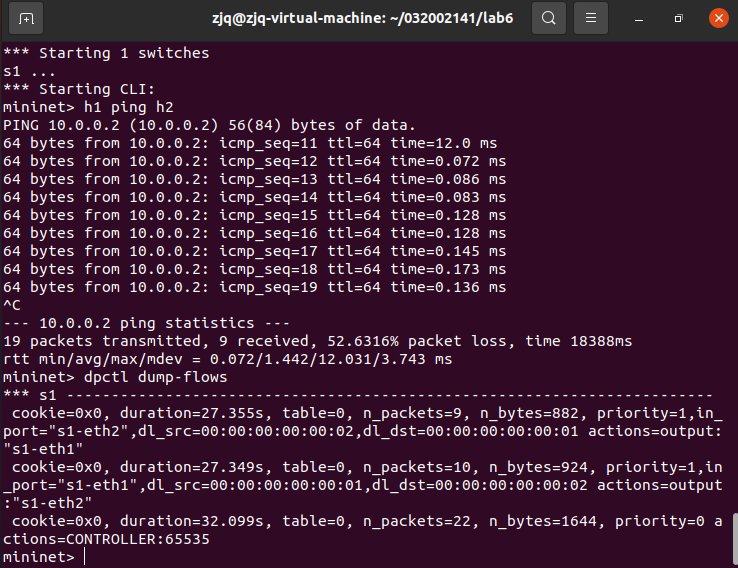
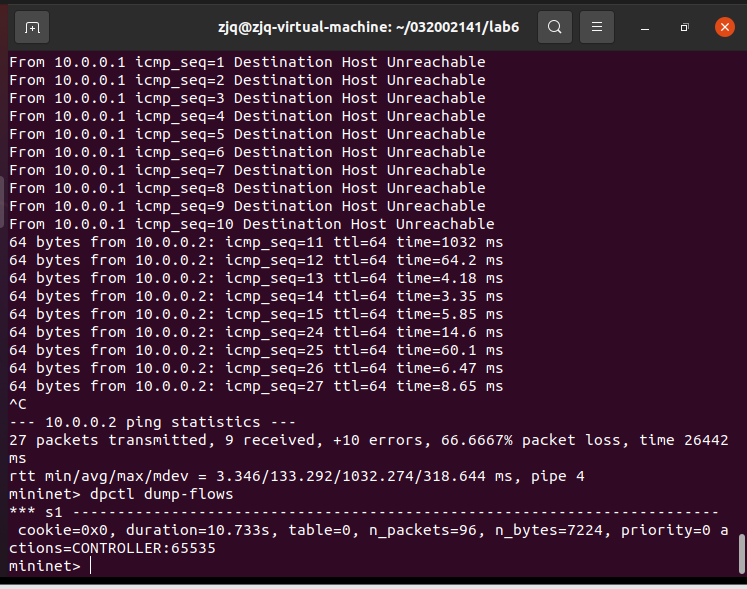
个人总结
- from ryu.ofproto import ofproto_v1_3意思是导入openflow1.3协议的数据,使用openflow1.3协议
- 通过Ryu的图形界面查看网络拓扑时出现问题,就是运行ryu-manager ryu/ryu/app/gui_topology/gui_topology.py --observe-links
解决方法:重启计算机,再根据指定路径在文件夹里开启终端运行该命令。
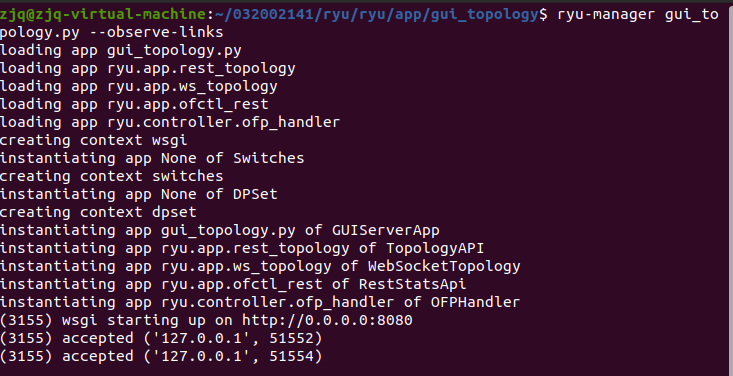
- 编程修改L2Switch.py,使之和POX的Hub模块的变得一致时,在里面使用的是openflow1.3协议,所以需要在建立拓扑的时候将后面的OpenFlow10改为OpenFlow13也可以直接删去;如果是改为OpenFlow13,在查看流表的时候还需要加入-O OpenFlow13即可以查看流表.原因:它默认版本为OpenFlow10

- 进阶里面的代码注释和需要回答的问题需要查阅比较多的资料去了解该代码所对应的功能!





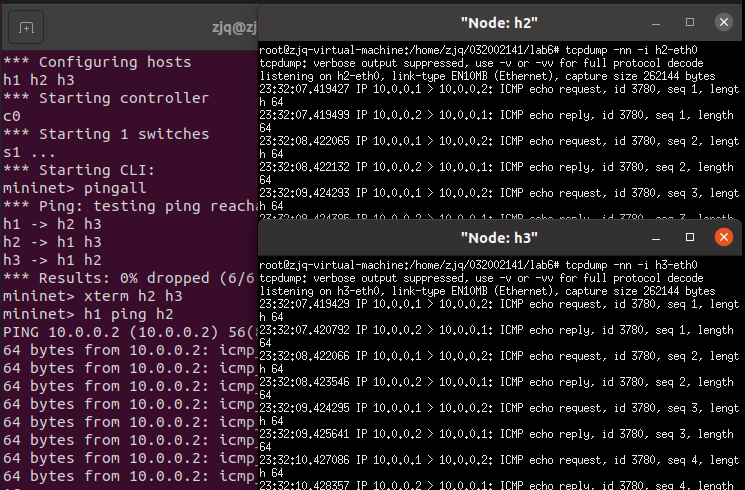

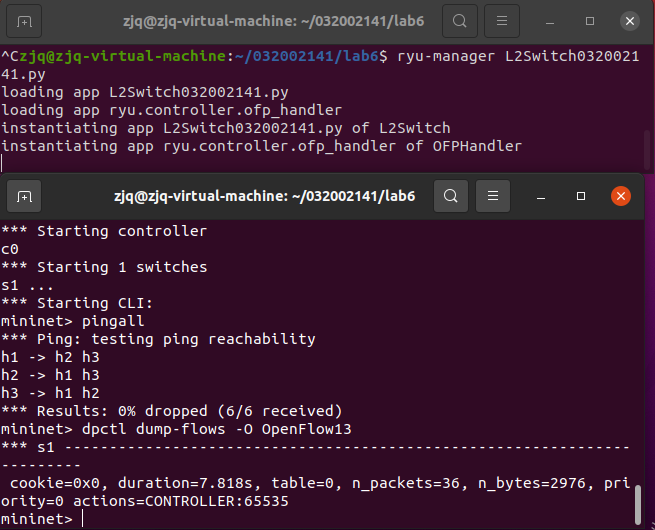


 浙公网安备 33010602011771号
浙公网安备 33010602011771号